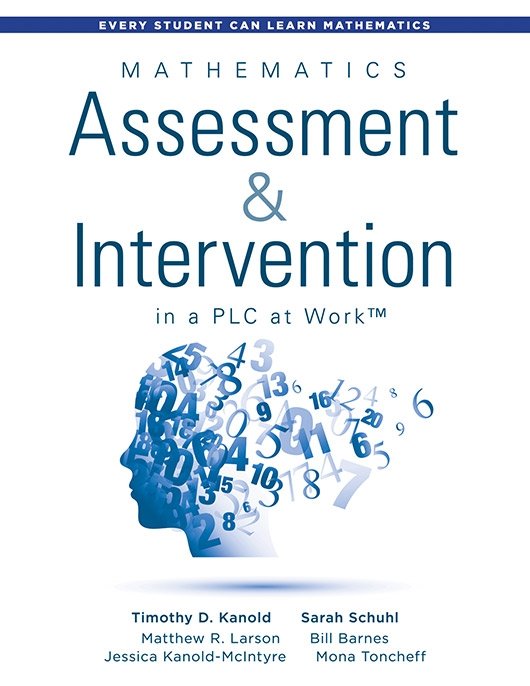Free Reproducibles
Mathematics Assessment and Intervention in a PLC at Work™
Harness the power of formative assessment processes within an RTI model (MTSS) to inspire student learning in mathematics. This user-friendly resource is divided into two parts, each covering a key team action for mathematics in a PLC at Work™. First you’ll learn how to develop high-quality common assessments. Then discover how to use the mathematics assessments for formative student learning and intervention. The book features unit samples for learning standards, sample unit exams, student performance trackers, and more.
Benefits
- Explore an assessment model for writing quality common assessments.
- Utilize RTI Tier 2 intervention strategies for effectively responding to student learning.
- Make sense of the grade-level content standards and corresponding tasks.
- Learn how to write quality common unit assessments and score them accurately.
- Determine how students can reflect and set performance goals using common unit assessment results.
- Develop a Tier 2 RTI math intervention program to support student learning.
Table of Contents
PART 1: TEAM ACTION 1: Develop High-Quality Common Assessments for the Agreed-On Essential Learning Standards
Chapter 1: The Purpose and Benefit of Common Mathematics Assessments
Chapter 2: Quality Common Mathematics Unit Assessments
Chapter 3: Sample Common Mathematics Unit Assessments and Collaborative Scoring Agreements
Part 1 Summary
Chapter 4: Quality Mathematics Assessment Feedback Processes
Chapter 5: Team Response to Student Learning Using Tier 2 Mathematics Intervention Criteria
Chapter 6: Student Action on Assessment Feedback During the Unit
Part 2 Summary
Appendix: Cognitive-Demand-Level Task Analysis Guide
Reproducibles
Introduction
- Figure I.2: Mathematics in a PLC at Work Framework
- Online Resources Reference Guide for Mathematics Support
Chapter 1
Chapter 2
- Figure 2.1: Team Discussion Tool—Assessment Instrument Quality Evaluation Rubric
- Figure 2.2: Team Discussion Tool—High-Quality Assessment Evaluation
- Figure 2.3: Sample Grade 4 Fractions Unit—Essential Learning Standards
- Figure 2.4: Examples of Lower- and Higher-Level-Cognitive-Demand Tasks
- Figure 2.5: Team Discussion Tool—Sample Assessment Questions for Team Scoring
- Figure 2.6: Team Discussion Tool—Scoring Assessment Tasks
- Online Resources Reference Guide for Mathematics Support
Chapter 3
- Figure 3.1: Grade 1 Common Mid-Unit Assessment Place Value Sample
- Figure 3.2: Grade 8 Common Mid-Unit Assessment Solving Linear Equations Sample
- Figure 3.3: Team Discussion Tool—Sample Grade 4 End-of-Unit Assessment
- Figure 3.4: Team Discussion Tool—Sample High School Algebra 1/Integrated Mathematics I End-of-Unit Assessment
- Figure 3.5: Grade 4 Fractions End-of-Unit Sample Assessment Scoring Rubric
- Figure 3.6: Algebra 1/Integrated Mathematics I End-of-Unit Sample Assessment Scoring Rubric
- Figure 3.8: Team Discussion Tool—Assessment Instrument Alignment and Scoring Rubric
Chapter 4
- Figure 4.1: Team Discussion Tool—Formative Use of Common Assessments
- Figure 4.2: Team Discussion Tool—Common Unit Assessment Formative Process Evaluation
- Figure 4.3: Team Discussion Tool—Equitable Scoring and Calibration
Chapter 5
- Figure 5.1: Team Discussion Tool—Intervention Practices
- Figure 5.2: Mathematics Intervention Program Evaluation Tool
- Figure 5.3: Team Discussion Tool—Mathematics Intervention Planning Tool
Chapter 6
- Figure 6.2: Grade 3 Student Tracker—Self-Assessment and Action Plan
- Figure 6.3: High School Student Tracker—Self-Assessment and Action Plan
- Figure 6.4: Team Discussion Tool—Collaborative Team Feedback With Student Action
Proficiency Maps
Unit Essential Learning Standards
- Sample Algebra 1/Integrated Mathematics 1 Unit: Linear Functions—Essential Learning Standards
- Sample Grade 1 Unit: Using Tens and Ones to Compare, Add, and Subtract—Essential Learning Standards
- Sample Grade 7 Unit: Proportional Reasoning: Essential Learning Standards
Example Assessment Questions by Grade
- Online Grade 1 Assessment Question: Figure 2.5
- Online Grade 2 Assessment Question: Figure 2.5
- Online Grade 4 Assessment Question: Figure 2.5
- Online Grade 5 Assessment Question: Figure 2.5
- Online Grade 7 Assessment Question: Figure 2.5
- Online Grade 8 Assessment Question: Figure 2.5
Scoring Agreements for Online Assessment Questions
- Example of Task Points or Proficiency Scale Scores for Online Grade 1 Task: Figure 2.7
- Example of Task Points or Proficiency Scale Scores for Online Grade 2 Task: Figure 2.7
- Example of Task Points or Proficiency Scale Scores for Online Grade 4 Task: Figure 2.7
- Example of Task Points or Proficiency Scale Scores for Online Grade 5 Task: Figure 2.7
- Example of Task Points or Proficiency Scale Scores for Online Grade 7 Task: Figure 2.7
- Example of Task Points or Proficiency Scale Scores for Online Grade 8 Task: Figure 2.7
Student Work With Team Scoring for Online Assessment Questions
- Sample Online Grade 1 Assessment Question With Team Scoring: Figure 2.8
- Sample Online Grade 2 Assessment Question With Team Scoring: Figure 2.8
- Sample Online Grade 4 Assessment Question With Team Scoring: Figure 2.8
- Sample Online Grade 5 Assessment Question With Team Scoring: Figure 2.8
- Sample Online Grade 7 Assessment Question With Team Scoring: Figure 2.8
- Sample Online Grade 8 Assessment Question With Team Scoring: Figure 2.8
Common Mid-Unit Assessments
- Assessment Sheet: Compare Written Numbers
- Sample Grade K Common Mid-Unit Assessment: Compare Written Numbers
Common End-of-Unit Assessments With Scoring Agreements and Student Reflections
- Sample Grade 1 End-of-Unit Assessment Using Tens and Ones to Compare, Add, and Subtract
- Sample Grade 7 End-of-Unit Assessment: Proportional Reasoning
- Sample Student End-of-Unit Self-Assessment: Grade 7 Unit—Proportional Reasoning
Suggested Resources
Books
- DuFour, R., DuFour, R., Eaker, R., Many, T. W., & Mattos, M. (2016). Learning by Doing: A Handbook for Professional Learning Communities at Work™ (3rd ed.). Bloomington, IN: Solution Tree Press.
- Kanold, T. D., Barnes, B., Larson, M. R., Kanold-McIntyre, J., Schuhl, S., & Toncheff, M. (2018). Mathematics Homework and Grading in a PLC at Work™. Bloomington, IN: Solution Tree Press.
- Kanold, T. D., Kanold-McIntyre, J., Larson, M. R., Barnes, B., Schuhl, S., & Toncheff, M. (2018). Mathematics Instruction and Tasks in a PLC at Work™. Bloomington, IN: Solution Tree Press.
- Kanold, T. D., Toncheff, M., Larson, M. R., Barnes, B., Kanold-McIntyre, J., & Schuhl, S. (2018). Mathematics Coaching and Collaboration in a PLC at Work™. Bloomington, IN: Solution Tree Press.
Websites

